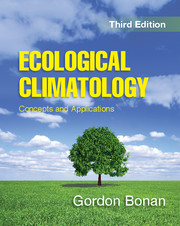Book contents
- Frontmatter
- Dedication
- Contents
- Preface
- 1 Ecosystems and Climate
- Part I The Earth System
- Part II Global Physical Climatology
- Part III Hydrometeorology
- 9 Soil Physics
- 10 Water Balance
- 11 Watershed Hydrology
- 12 Surface Energy Fluxes
- 13 Turbulent Fluxes
- 14 Soil Moisture and the Atmospheric Boundary Layer
- Part IV Biometeorology
- Part V Terrestrial Plant Ecology
- Part VI Terrestrial Forcings and Feedbacks
- Appendix
- Index
- Plate section
- References
11 - Watershed Hydrology
from Part III - Hydrometeorology
Published online by Cambridge University Press: 05 November 2015
- Frontmatter
- Dedication
- Contents
- Preface
- 1 Ecosystems and Climate
- Part I The Earth System
- Part II Global Physical Climatology
- Part III Hydrometeorology
- 9 Soil Physics
- 10 Water Balance
- 11 Watershed Hydrology
- 12 Surface Energy Fluxes
- 13 Turbulent Fluxes
- 14 Soil Moisture and the Atmospheric Boundary Layer
- Part IV Biometeorology
- Part V Terrestrial Plant Ecology
- Part VI Terrestrial Forcings and Feedbacks
- Appendix
- Index
- Plate section
- References
Summary
Chapter Summary
The flow of water in streams and rivers is a key measure of the hydrologic cycle integrated over large areas. A watershed is the geographic area that contributes to water flow in a stream or river. Building upon concepts introduced in the previous chapter, this chapter introduces the study of watersheds. The overall hydrologic balance of a watershed is discussed, and three cases studies (Hubbard Brook, Coweeta, and Walker Branch) illustrate the hydrologic balance of watersheds. Surface runoff, or overland flow, is generated within a watershed when water reaching the ground exceeds the soil's capacity to gain water during infiltration (infiltration-excess runoff) or when rain falls on saturated areas of the watershed (saturation-excess runoff). The processes that generate runoff are reviewed and illustrated by numerical models of watershed hydrology. The spatial distribution of precipitation, spatial variability in infiltration capacity, antecedent soil moisture, and topography are important determinants of runoff at the watershed scale. Riverflow is an integrator of runoff, and the processes regulating riverflow, especially flooding, are discussed and illustrated. The chapter concludes with a discussion of global drainage basins and observed riverflow for major river systems. Comparison of simulated versus observed riverflow is one means to test the hydrologic cycle of climate models.
Watersheds
The cycling of water depicted in Figure 10.1 can be applied to particular geographic regions to calculate the water balance. One such area is a watershed or drainage basin. A watershed is the geographic area that contributes to flow in a stream or river. It can be hundreds of thousands of square kilometers for a large river such as the Mississippi or Amazon or a few square kilometers for a small creek. A watershed is topographically defined; it is bounded along its edges by divides formed from high elevation points. A drop of water on the streamward side of the divide flows downslope to the stream; a drop of water on the other side of the divide flows into another stream.
- Type
- Chapter
- Information
- Ecological ClimatologyConcepts and Applications, pp. 173 - 192Publisher: Cambridge University PressPrint publication year: 2015



